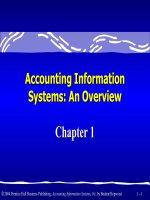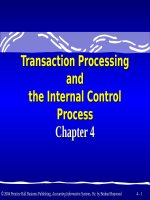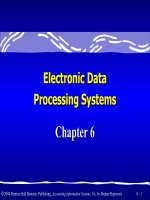Accounting information system an overview 9e bodnar hopwood chapter 01
Bạn đang xem bản rút gọn của tài liệu. Xem và tải ngay bản đầy đủ của tài liệu tại đây (1.58 MB, 46 trang )
Accounting Information
Systems: An Overview
Chapter 1
2004 Prentice Hall Business Publishing, Accounting Information Systems, 9/e, by Bodnar/Hopwood
1–1
Learning Objective 1
Understand the related concepts
of transaction cycles and
internal control structure.
2004 Prentice Hall Business Publishing, Accounting Information Systems, 9/e, by Bodnar/Hopwood
1–2
Overview
An accounting information system (AIS)
is a collection of resources designed to
transform data into information.
Accounting information systems
perform this transformation.
Manual
Computerized
2004 Prentice Hall Business Publishing, Accounting Information Systems, 9/e, by Bodnar/Hopwood
1–3
Information and Decisions
Who are the two main users
of accounting information?
External users
Internal users
2004 Prentice Hall Business Publishing, Accounting Information Systems, 9/e, by Bodnar/Hopwood
1–4
Information and Decisions
Who are the external users
of accounting information?
Stockholders
Investors
Creditors
Government agencies
Customers and vendors
2004 Prentice Hall Business Publishing, Accounting Information Systems, 9/e, by Bodnar/Hopwood
1–5
Information and Decisions
Hierarchy of Internal Users
Top-Level
Management
Middle
Management
Lower-Level
Management
Strategic
Tactical
Summarization
and Filtration
Operational
Transaction oriented
2004 Prentice Hall Business Publishing, Accounting Information Systems, 9/e, by Bodnar/Hopwood
1–6
Information Systems
The term information system suggests the use
of computer technology in an organization.
Hardware
Data
Information
Software
2004 Prentice Hall Business Publishing, Accounting Information Systems, 9/e, by Bodnar/Hopwood
1–7
Information Systems
Electronic Data Processing System (EDP)
Data Processing System (DP)
Management Information System (MIS)
Decision Support System (DSS)
Expert System (ES)
Executive Information System (EIS)
Accounting Information System (AIS)
2004 Prentice Hall Business Publishing, Accounting Information Systems, 9/e, by Bodnar/Hopwood
1–8
Business Processes
Data
Organizational
units
Logical time
sequence
2004 Prentice Hall Business Publishing, Accounting Information Systems, 9/e, by Bodnar/Hopwood
1–9
Business Processes
Primary Business Processes
Inbound
sales
logistics
Outbound
sales
logistics
Marketing
Operations
Service
2004 Prentice Hall Business Publishing, Accounting Information Systems, 9/e, by Bodnar/Hopwood
1–
Business Processes
Supporting Business Processes
Procurement
Technology
development
Human
resources
Firm
infrastructure
2004 Prentice Hall Business Publishing, Accounting Information Systems, 9/e, by Bodnar/Hopwood
1–
Transaction Processing Cycles
1. Revenue cycle
2. Expenditure cycle
3. Production cycle
4. Finance cycle
2004 Prentice Hall Business Publishing, Accounting Information Systems, 9/e, by Bodnar/Hopwood
1–
Internal Control Process
Reliability of financial reporting
Effectiveness and efficiency
Compliance
2004 Prentice Hall Business Publishing, Accounting Information Systems, 9/e, by Bodnar/Hopwood
1–
Internal Control Process
What are the elements of internal control?
Control environment
Risk assessment
Control activities
Information and communication
Monitoring
2004 Prentice Hall Business Publishing, Accounting Information Systems, 9/e, by Bodnar/Hopwood
1–
Internal Control Process
Segregation of Duties:
No individual or department should
control the accounting records
relating to its own operation.
Internal Auditing:
It is an independent appraisal
activity within the organization.
2004 Prentice Hall Business Publishing, Accounting Information Systems, 9/e, by Bodnar/Hopwood
1–
Learning Objective 2
Describe the organizational
structure of the information
system function in organizations.
2004 Prentice Hall Business Publishing, Accounting Information Systems, 9/e, by Bodnar/Hopwood
1–
The Information System Function
Chief
Information
Officer
Steering
Committee
Manager
Systems
Analysis
Manager
Programming
Manager
Operations
Manager
Technical
Support
2004 Prentice Hall Business Publishing, Accounting Information Systems, 9/e, by Bodnar/Hopwood
Manager
User
Support
1–
The Information System Function
Manager
Systems
Analysis
Manager
Programming
Application
Analysts
Application
Programmers
2004 Prentice Hall Business Publishing, Accounting Information Systems, 9/e, by Bodnar/Hopwood
1–
The Information System Function
Manager
Operations
Maintenance
Programmers
File
Librarian
Data
Entry
Operators
Computer
Operators
2004 Prentice Hall Business Publishing, Accounting Information Systems, 9/e, by Bodnar/Hopwood
1–
The Information System Function
Manager
Technical
Support
Systems
Programmers
Communication
Analysts
Database
Administration
2004 Prentice Hall Business Publishing, Accounting Information Systems, 9/e, by Bodnar/Hopwood
1–
The Information System Function
Project organizations
Analysts
Programmers
Application projects
2004 Prentice Hall Business Publishing, Accounting Information Systems, 9/e, by Bodnar/Hopwood
1–
Learning Objective 3
Discuss applications of
information technology
in organizations.
2004 Prentice Hall Business Publishing, Accounting Information Systems, 9/e, by Bodnar/Hopwood
1–
End-User Computing
End-user computing (EUC) is the
hands-on use of computers by end users.
Functional end users do their own
information processing activities.
2004 Prentice Hall Business Publishing, Accounting Information Systems, 9/e, by Bodnar/Hopwood
1–
EUC: Mainframe Application
Database
Database
Accounts
AccountsReceivable
Receivable
Data
Data
User
UserReport
Report
Query
QueryLanguage
Language
Processor
Processor
User
UserSubmits
Submits
Query
QueryLanguage
Language
Job
Job
Database
Database
Access
AccessControl
Control
Software
Software
2004 Prentice Hall Business Publishing, Accounting Information Systems, 9/e, by Bodnar/Hopwood
1–
Data Processing for the End User
Traditional Approach
User
Information System
Specialists
Data
Processing
2004 Prentice Hall Business Publishing, Accounting Information Systems, 9/e, by Bodnar/Hopwood
1–









